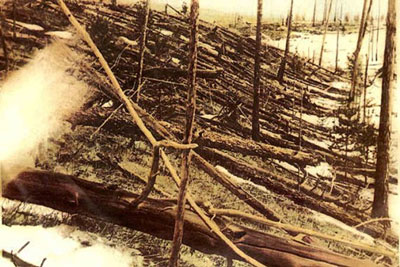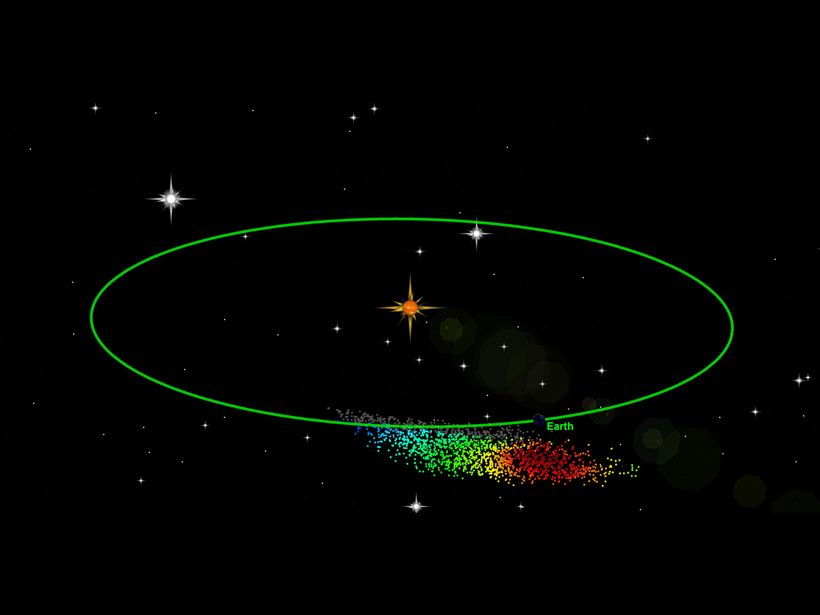Look for fireballs during nights of watching the sky over the next few weeks—and perhaps even during the day.
From the end of June until about mid-August, Earth will pass through the Taurid Complex, a collection of rock and dust linked to an increased number of upper atmosphere incendiaries. A new model predicts that Earth will be closer to the heart of the swarm than it has been in almost 45 years, providing not only a treat for sky watchers but also an opportunity to investigate the mystery of where these objects come from and whether Earth might suffer a Taurid-related impact in the future.
The new calculations suggest that Earth will pass within 10 million kilometers of the center of the swarm, a dense cluster of objects within the larger Taurid meteoroid stream.
“It gives us a great opportunity to view it,” says David Clark, a graduate student at Western University in London, Ontario, Canada. Clark is lead author on the new research, which was published in Monthly Notices of the Royal Astronomical Society. After analyzing several visible fireballs during the 2015 passage, the astronomers modeled the motion of the swarm’s core.

Sky watchers in Earth’s Southern Hemisphere will catch a glimpse between 5 and 11 July, whereas those in both hemispheres will get a peek between 21 July and 10 August. Watchers will catch another glimpse of the meteor shower in late August, but at that time conditions won’t be at their peak for astronomers to study the swarm’s dimmest objects.
Determining how many of these smaller objects travel in the swarm could help researchers understand a potential threat to our planet.
By observing the quantity of 100-meter near-Earth objects (NEOs) within the swarm, Clark and his colleagues hope to constrain the number of potentially dangerous objects that could one day collide with Earth. Current estimates by NASA’s Center for Near Earth Object Studies put the odds of a 100-meter impactor hitting the planet at once every 10,000 years. But if the Taurid stream contains a cluster of objects that Earth passes through periodically, the threat could increase, Clark says. Determining how many of these smaller objects travel in the swarm could help researchers understand a potential threat to our planet.
Mysterious Origins
The Taurid meteor shower has been linked to an increase in fireballs in 1995 and 2005, as well as to more than 100 in 2015. It has also been connected to the Tunguska event of 1908, the largest impact event in recorded history, in which a 60- to 190-meter meteorite exploded in the air over Russia and flattened 2,000 square kilometers of forest.

Although most meteor showers come from debris left behind from comets, the Taurids’ source remains a puzzle. The showers, which occur twice a year over a span of several weeks, have been connected to comet 2P/Encke, but the comet today is too weak to produce enough material to fuel them. In the past, scientists have speculated that a massive comet, as large as 5 kilometers across, was destroyed through interactions with the Sun. Encke and its smaller siblings may be all that remain of the giant.
In the past, two independent teams of researchers have analyzed the makeup of NEOs associated with the Taurids. Although both found that the composition of their targets was predominantly primordial, the larger mystery remains.
“The comet is the odd one out,” says Alan Fitzsimmons, who studies meteors at Queen’s University Belfast and was not part of the recent research. Encke’s oddness doesn’t rule out a giant comet origin, but it makes it less likely, Fitzsimmons says.
The second team, led by Marcel Popescu of the Observatoire de Paris, found that one of the six largest targets related to the Taurids could be a meteorite primitive enough to be related to Encke. “One is a positive result,” says Popescu, pointing out that his team’s observations support the possibility of a giant comet origin.
Scanning the Skies
Clark and his colleagues are currently working to find telescopes to target the Taurids. They currently plan to study the heart of the stream with the Canada-France-Hawaii Telescope in Hawaii and are hoping to get observations from the Dark Energy Camera in Chile.
“There’s nothing to be worried about, but keep an eye on the sky and you might…see something pretty impressive.”
The largest objects in the Taurid swarm may show up on surveys already dedicated to hunting down NEOs. “We’ll use as many resources as people volunteer to take us up on,” Clark says.
The cluster will likely be too dim for amateur astronomers to spot.
Although scientists aren’t anticipating a significant threat to Earth this summer, they are looking forward to seeing fireballs.
“There’s nothing to be worried about, but keep an eye on the sky and you might…see something pretty impressive,” Fitzsimmons says. “The chance of [an] impact by a large Taurid is still low, but the chance of seeing a really impressive fireball burning up in the upper atmosphere is not so bad.”
—Nola Taylor Redd (@nolatredd), Freelance Journalist
Citation:
Redd, N. T. (2019), Summer fireballs could provide clues to an outstanding meteor mystery, Eos, 100, https://doi.org/10.1029/2019EO127375. Published on 09 July 2019.
Text © 2019. The authors. CC BY-NC-ND 3.0
Except where otherwise noted, images are subject to copyright. Any reuse without express permission from the copyright owner is prohibited.

